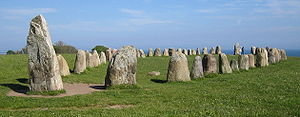
Back Radiometriese datering AF تأريخ إشعاعي Arabic Радиоизотопно датиране Bulgarian Datació radiomètrica Catalan Radioaktivní datování Czech Radiometrische Datierung German Radiometric dating English Datación radiométrica Spanish تاریخگذاری پرتوسنجشی FA Datation radiométrique French

Radiometric dating (often called radioactive dating) is a way to find out how old something is. The method compares the amount of a naturally occurring radioactive isotope and its decay products, in samples. The method uses known decay rates.[2] It is the most used method of geochronology, the main way to learn the age of rocks and other geological features, including the age of the Earth itself.
It is used to date many kinds of natural and man-made materials. Fossils may be dated by taking samples of rocks from above and below the fossil's original position. Radiocarbon dating is much used to date archaeological materials, including ancient artifacts.
Radiometric dating methods are used to establish the geological time scale.[3] Among the best-known techniques are radiocarbon dating, potassium-argon dating and uranium-lead dating.
- ↑ "Ales stenar". The Swedish National Heritage Board. 11 October 2006. Archived from the original on 31 March 2009. Retrieved 9 March 2009.
- ↑ International Union of Pure and Applied Chemistry. Radioactive dating. Compendium of chemical terminology, internet edition. [1]
- ↑ McRae A. 1998. Radiometric dating and the geological time scale: circular reasoning or reliable tools? Radiometric dating and the geological time scale. TalkOrigins Archive